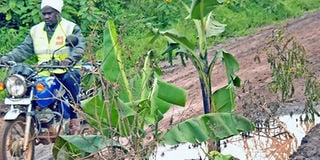Farmers use traditional means to forecast highly unpredictable weather

A motorcycle rider passes past a paddle of water during a rain season. Indigenous knowledge of weather patterns is key to helping communities grow food more efficiently. FILE PHOTO | NMG
What you need to know:
- The arrival of certain migratory birds such as swallows or the Abyssinian hornbill is one indication of pending rain.
- Older farmers feel their younger peers have neglected this local knowledge, she says, which is why they fail to read nature's warning signals.
- Zaverio Chabari, the executive director of Strategies for Agro-Pastoralists Development Kenya, a non-profit that works with climate change, food security, soil and water management, says local knowledge is often accurate.
- Some farmers dismiss conventional forecasts as unreliable and of limited value — and often too late to be useful.
For some farmers, the giveaway is when the frogs croak continuously in a certain way. For others, it is seeing flowers breaking out on the acacia trees, or the reappearance of bees.
But for Flora Wanja, a resident of Kamatungu village, some 180km northeast of Nairobi, the surest sign that the rains are coming is the behaviour of a particular insect.
"When the Miunjuri insect specifically is seen jumping up and down very close to the ground for a prolonged period, it's an indication that rains will begin and farmers should prepare accordingly and start planting," she says.
As the climate becomes less predictable, and with life on the land as uncertain as ever, many small-scale farmers in Kenya continue to rely on traditional means to divine the weather.
When are the rains coming? Is now the best time to plant? Will there be a drought? Nature has the answer to those key questions, older farmers say, provided you know where to look.
In doing so, many rely not on the radio for forecasts. Instead, they look to the behaviour of animals and plants, as well as factors like wind direction, the early morning air temperature, or the way certain clouds move before sunrise.
The arrival of certain migratory birds such as swallows or the Abyssinian hornbill is one indication of pending rain.
Also, some animals mate more often, and some plants start to bloom. And you can tell when drought is coming because the trees will be full of caterpillars.
Many farmers in areas like Tharaka-Nithi County, where Kamatungu village lies, depend on rain — not irrigation — to water their crops, and unpredictable weather exacerbates food insecurity, said Catherine Kijiru, a community group support coordinator.
Older farmers feel their younger peers have neglected this local knowledge, she says, which is why they fail to read nature's warning signals.
"Despite the fact that there is climate change, the signs will always tell you whether there will be rain and whether it will be sufficient or insufficient," she says.
LACK ACCES TO CONVENTIONAL FORECASTING
"But when the aged speak, they are ignored, and that's why we are losing a lot of crops to droughts and other calamities as we ignore the advice and go ahead in planting.”
Zaverio Chabari, the executive director of Strategies for Agro-Pastoralists Development Kenya, a non-profit that works with climate change, food security, soil and water management, says local knowledge is often accurate.
"For instance, trees know when rain is about to fall and they will start shooting even if it's during a dry period. They also shed leaves at the onset of a dry period to indicate a lean season," he said.
Indigenous knowledge is key to helping communities grow food more efficiently, says Victor Mwiti Marangu, a regional technical officer with Kenya's Nutrition and Health Program.
Should the signs indicate a lack of rain, he says, then farmers could be better off planting drought-tolerant or early maturing crops such as millet, sorghum and groundnuts.
But the use of traditional methods to predict the weather is not solely a matter of choice, said Kijiru.
Many small-scale farmers use those methods — few of which have been formally documented — as they lack access to conventional forecasting.
Some farmers dismiss conventional forecasts as unreliable and of limited value — and often too late to be useful.
More positively, farmers like the fact that traditional forecasting is done in a style and language that suits local customs, and that it incorporates experience of disasters and climate changes learnt over generations.
Danson Kigoro Ireri, the director of meteorological services in Tharaka Nithi, says that though its good to use indigenous knowledge, its also wise to incorporate scientific knowledge as to get accurate forecast.





